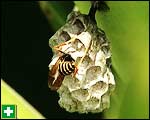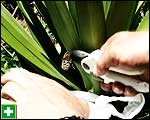Plant
Doctor Archive

Wasp
nest
 I
was cutting back the ivy that grows along my front fence, when I
found out the hard way that there is a wasp nest amongst it all!
I am a learner gardener. What is the best way to get rid of it? I
was cutting back the ivy that grows along my front fence, when I
found out the hard way that there is a wasp nest amongst it all!
I am a learner gardener. What is the best way to get rid of it?
 The
wasp you can see here is an oriental paper wasp. She's a fertilised
queen who hibernates all winter then comes out and makes a little
nest. The
wasp you can see here is an oriental paper wasp. She's a fertilised
queen who hibernates all winter then comes out and makes a little
nest.
 How? Simple. She grazes off some wood fibres — probably
off your deck — and then masticates them up. She makes them
into papier mache, a wonderful pliable material. Lovely little cells,
12, 14, 16 cells. And in each little cell she lays an egg. The egg
turns into a grub — her little baby — and she feeds them.
She goes out foraging for them, catches caterpillars and all sorts
of insects and honey and nectar, and keeps feeding her young.
How? Simple. She grazes off some wood fibres — probably
off your deck — and then masticates them up. She makes them
into papier mache, a wonderful pliable material. Lovely little cells,
12, 14, 16 cells. And in each little cell she lays an egg. The egg
turns into a grub — her little baby — and she feeds them.
She goes out foraging for them, catches caterpillars and all sorts
of insects and honey and nectar, and keeps feeding her young.
She'll catch caterpillars
on your cabbages and that may be good — it's natural biological
control — but unfortunately she does more damage to our natural
ecosystem than you will know.
 Here's an example. She loves the caterpillars of our native admiral
butterflies and they can be suffering as a result. My advice, despite
all the good work she's doing, is get rid of them.
Here's an example. She loves the caterpillars of our native admiral
butterflies and they can be suffering as a result. My advice, despite
all the good work she's doing, is get rid of them.
How? All you need is
a plastic bag and a pair of secateurs. Remember, do this at night
when they're home because you've got plenty of time.
Carefully put the plastic
bag under the nest and with the secateurs cut off the stalk. Let
the nest fall into the plastic bag and tie it up. What you do with
the bag is up to you. But the most humane way to dispatch them is
to put the bag in the freezer.
Further
information from the Council
 Advice
by Dr Dan Blanchon from Unitec's Diploma in Sustainable Horticulture and Bachelor
of Resource Management. Advice
by Dr Dan Blanchon from Unitec's Diploma in Sustainable Horticulture and Bachelor
of Resource Management.
Reproduced
with permission from NZOOM Home and Garden content,
from the previous
website of 
The views expressed here are not necessarily those of the RNZIH
 |
|
HOME
AND GARDEN
|
|
|
|